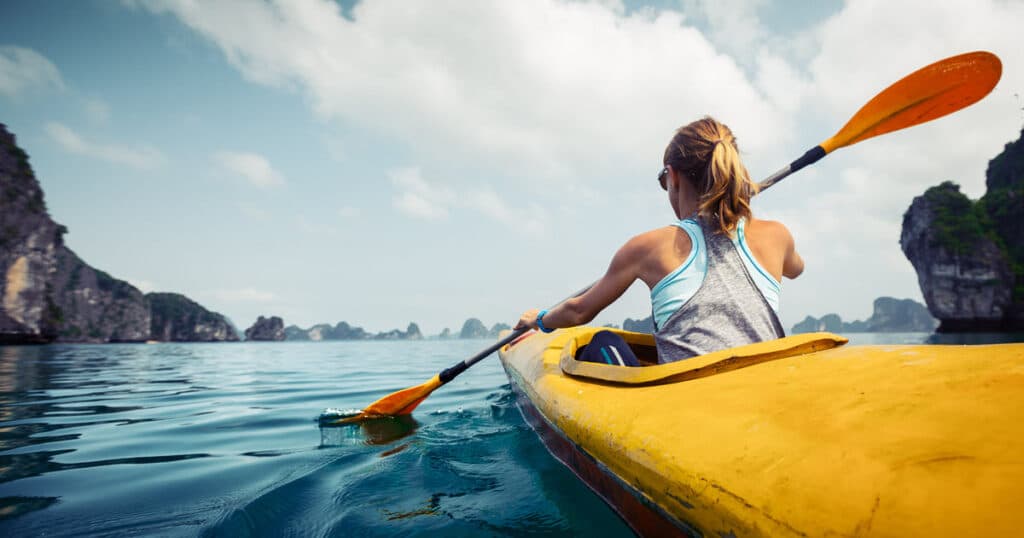Looking for a popular watersport that’s also an excellent workout? Try kayaking. It’s great cardiovascular exercise, and it will strengthen and tone your muscles as it burns calories. It’s the paddling motion in kayaking that puts your muscles to work. But which muscles does kayaking work? When you kayak, which muscles and parts of your body can you expect to see looking firmer and stronger over time?
Kayaking specifically works muscles in your arms, abdomen (or core), shoulders, and back. When it comes to the arms, you can expect to see toning of the forearms and biceps. When you kayak regularly over the longer term, you’ll eventually notice your abdomen getting firmer, with more noticeable muscling.
What Muscles are Used Most When Kayaking?
When you use proper kayaking form, what muscles are most used? As we discussed above, the muscles that kayaking works are in the:
- core,
- forearms and biceps,
- shoulders, and
- back.
It seems counterintuitive to beginners, but your core muscles are much more essential to kayaking than your arm muscles.
Correct Form Works the Right Muscles the Right Way
When you kayak with the correct form, your core muscles are key to stabilizing your kayak and moving it forward in the water. When we talk about core muscles, we mean all the muscles in your abdomen, pelvic floor, and the other muscles that bring together the lower and upper body.
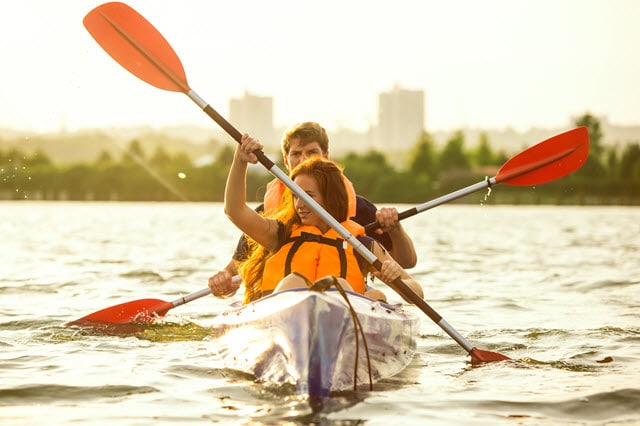
It’s the core muscles that allow you to keep up the right posture when you kayak. They are also necessary when you make the kayaking strokes for turning around and propelling your watercraft.
What is Proper Kayaking Form?
Ensure you stay braced at all times, and position your hands below the shoulders. Don’t make the mistake of gripping your paddle too tightly. It can cause unnecessary strain to your forearms, and make kayaking more difficult than it has to be.
In fact, if you do this too often over the long-term, you may end up with arthritis in your hand joints.
As you position your fingers and hands around your paddle, ensure the shaft is maneuvered by only your thumb and index fingers, both of which should be wrapped around the paddle shaft.
Ensure you grip quite loosely when you are in tranquil waters. Whitewater environments are different, of course. You will have to keep your grip tight or you may even lose hold of your paddle, and this is a dangerous situation.
You can read my full kayak paddling technique guide here.
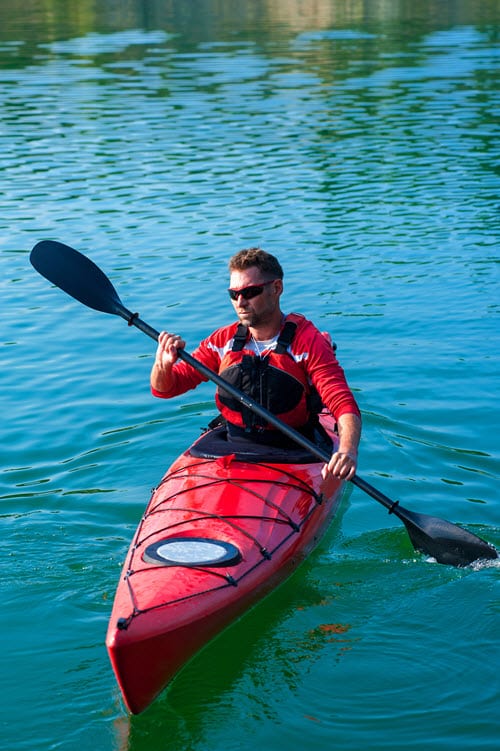
To protect your lower back muscles (which are among your core muscles), you must support them. This means you have to correctly adjust the kayak before you begin kayaking. This involves the backrest. Get it adjusted in a way that supports your lower back. If you want to kayak and not end up with back pain, this is essential.
If sounds strange, but your legs muscles are also significant in kayaking. It’s because they are essential for you to connect your body to the watercraft, helping to stabilize it.
As a beginner kayaker, you probably won’t notice this much, but more advanced kayakers engage their leg muscles quite a lot. As you kayak, you use your leg muscles together with your hips when you’re doing tasks such as bracing your kayak, turning your kayak, and rolling your kayak.
If you have problems with leg pain or soreness, your kayak may not be the right size. It’s probably not big enough, or perhaps the design or outfitting isn’t right.
Correct Kayak Paddling
Correct kayak paddling involves not only how to use your paddle, but how to hold it. Of course, as we mentioned earlier, you will have to hold your paddle more tightly when you’re in volatile water, such as whitewater rivers. But if you’re on calm waters, you won’t have to hold it as tightly.
You should probably start out with a sit-on-top kayak instead of a sit-in kayak, as they’re usually better for beginners.
Holding the Paddle Correctly
Holding your paddle the right way if more important than you think. When you hold your paddle correctly, you won’t get tired as quickly and you’ll move your kayak more quickly and efficiently.
Before you even get started, however, you have to make sure your kayak paddle is the right length. People of different heights require different paddle lengths, so ask an expert what length is the best for you to use. You can ask at your local paddle shop, or even a kayaking guide.
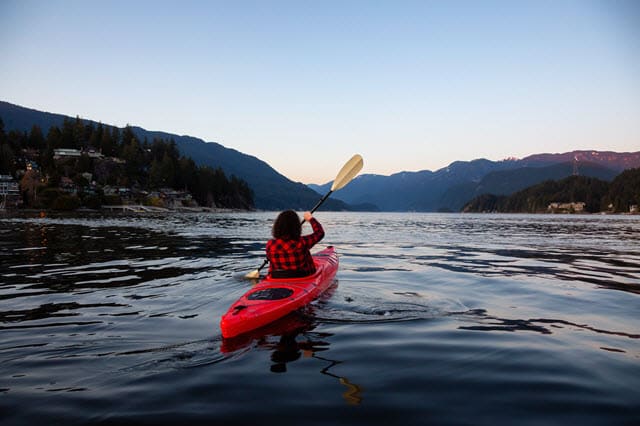
To hold your paddle correctly, you’ve got to have certain information. This includes:
- understanding your paddle blade type,
- knowing how to position the blades in the right orientation,
- knowing how to adjust your grip on the paddle shaft at the appropriate times, and
- understanding how to relax your grip at the appropriate times.
How Do You Know if Your Form is Wrong?
There are certain aches and pains that may indicate you’ve been using the wrong form. For example, you may experience back pain if you are not kayaking the right way. It can also be an indication that you’re not stretching before kayaking.
Take time to do stretching exercises before and after kayaking. When you kayak, you get contraction of the iliopsoas, a crucial back muscle. You need to stretch after kayaking to help lengthen it out again. Leaving your iliopsoas too short will eventually cause painful problems with your back discs.
Incorrect kayaking form risks injuries to your shoulder muscles. Water movement is powerful, and it can propel your arms outside of your kayak’s paddler’s box if you don’t maintain proper balance and stroke movements.
If this happens, your shoulder may get injured. So, make sure you stay aware and alert during your kayaking expeditions. If you let your guard down and lose the proper form, your shoulders may leave the paddler’s box.
How Do You Alleviate Muscle Pain from Kayaking?
There are several different approaches you can try to alleviate pain in the muscles that kayaking works. Let’s explore them below.
Move Your Muscles
It sounds counterintuitive, but stretching and flexing your sore muscles may actually help them feel better. You want to improve your blood flow, to encourage healing and regeneration. With better blood flow, you will enjoy better elasticity in your muscle tissue.
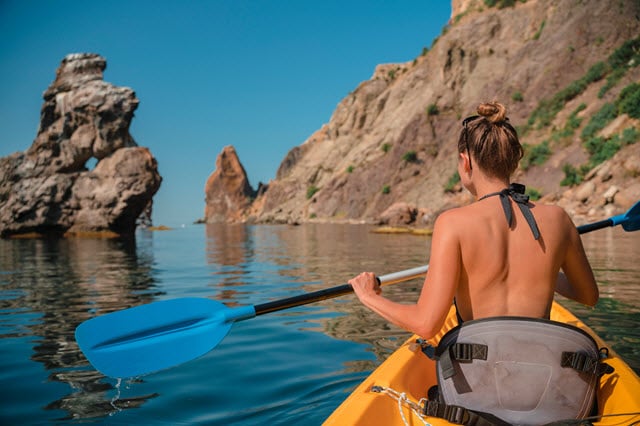
As a result, you have less soreness in the muscles kayaking works. I always spend a lot of time doing stretches as soon as I get back to shore.
Try an Epsom Salt Soak
Add some Epsom salt to warm water in the bath, and enjoy a long and relaxing soak. It’s the magnesium in Epsom salt that helps with muscle soreness and pain.
Wear Compression Clothing
Some kayakers wear compression clothing because it helps prevent and soothe muscle soreness.
Invest in some compression clothing items to wear during kayaking. You can also wear compression clothing after you’re back on shore, to help alleviate soreness.
Chew on Ginger
Chewing on ginger can help to cut down on your muscle pain. In fact, there have been studies showing that eating raw ginger may go quite a long way in dealing with your sore muscles.
Enjoy a Cup of Coffee
I’m a caffeine fan, so this might be my favorite remedy! That’s right, sipping on a hot cup of Joe often helps alleviate muscle pain from kayaking. In fact, drinking any beverage containing caffeine may help you deal with muscle soreness.
Or more accurately, it may cut down on how much you perceive the soreness of your muscles. If you don’t like coffee, try some black tea or another caffeinated beverage.
Final Thoughts: What Muscles Does Kayaking Work?
As we’ve seen here, kayaking works specific muscles in the body, such as the core muscles, arms, shoulders, and back.
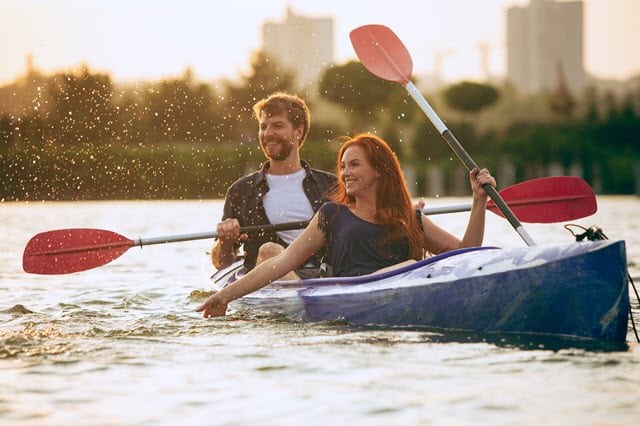
Now you know how to prevent and alleviate muscle pain if you want to try this popular recreational activity out on the water (and get in a good workout while you’re at it).

